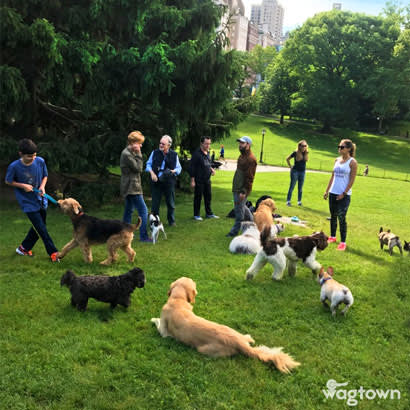
Wagtown® research shows off-leash options attract park users
Long ago, dogs roamed free without rules or owners. Times have changed. Dogs don’t have owners, they have families. People are deciding where to live, work and play based on dog-welcoming infrastructure and policies. This presents opportunities for park professionals to embrace this growing relevance driver.
Wagtown, a nonprofit dedicated to setting responsible and genuine standards for authentic dog friendliness and the nation’s leading dog-friendly community expert, interviewed more than 400 leaders across the country. Following two years of intense research, we have insights from economic development, land-use planning, tourism, law enforcement, animal advocacy, park and recreation administration, park users and more. Front-runners see a surge of interest in dog-friendly open spaces like we’ve never seen before. In its Unleashed: Off-Leash Dog Park Design Trends and Planning Tips guidebook, PlayCore, a company focused on building communities through play and recreation, states: “Dog parks help both pets and owners increase enjoyment for the outdoors, while providing a wealth of additional health and well-being benefits, as well as social and community advancements.”
Park districts are embracing dog lovers because dogs bring their owners along for the run, hike, walk, paddle or to just enjoy the serenity of the open space with their best friend. Dog-friendly areas are safer because dog walkers are hypervigilant patrollers of their parks. In addition, regardless of socioeconomic background, American park users are increasingly counting Fido as one of the family. This gives parks a key to the hearts of their user constituents regardless of race, education, income, interests, etc.
New attitudes about dogs mean changing expectations for park services. Leaders recognize the value of dogs and their role in parks, but there isn’t a quick answer on how to react to the demand. There is not “one right way” to create an off-leash experience. Three well-recognized categories for off-leash play are noted in Seattle C.O.L.A. (Coalition for Off-Leash Areas) Best Practices Report. These categories are especially helpful in high demand and urban areas where mixed use is necessary.
Option A: Off-leash dogs under voice/sight control are free to share recreational space with non-dog users where indicated within specified times.
A great example of this format can be found in bustling New York City, where several dozen dogs can be found before 9 a.m. and after 9 p.m. on “The Hill” of Central Park. The busy urbanites scurry through the streets seeking green respite for their dogs.
Wagtown visited the park in 2016 and found that users understand that responsible dog ownership is critical to the success of the experience they treasure. Because the dogs come regularly to a well-maintained area, their social game is stellar. Then, like clockwork, when time’s up, you can hear the clicking of leashes on collars as they gather up their floppy-eared family members and head elsewhere.
Option B: Off-leash dogs under voice/sight control are free to share recreational space with non-dog users where indicated in specified zones of the park.
These areas encourage users to share recreation space with dogs in a safe and equable way. Because it is important to allow some buffer zone, some areas may be too small to combine groups.
In Redmond, Washington, there is a community park with one of the most inspiring off-leash areas in America. Marymoor Dog Park (www.soda.org/volunteer-at-marymoor/) is well-planned and supported by the community leadership and the grassroots organization, Serve our Dog Areas (S.O.D.A.).
S.O.D.A. has developed and sustained a volunteer effort to provide assistance in dog spaces. From fence installation and repair to dog wash stations and coffee bars, members of the dog community have rolled up their sleeves and contributed to an incredible experience for dogs and their owners. The parks have provided guidance, materials, training and a financial commitment to help maintain excellence.
They have installed wayfinding, site signage and natural barriers and offer specialty vendors. Visitors can enjoy a cup of coffee from the caboose café or treat their dog to a bath before climbing aboard for the car ride home. Although Marymoor delivers a top-notch experience, it is open to the public with just a $1 parking fee. The sheer number of dogs of all shapes and sizes in this space was impressive and speaks volumes about socialization of dogs and the irrelevance of breed.
Option C: Off-leash dogs with a permit and under voice/sight control are free to share recreational space with non-dog users where indicated in specified zones of the park.
Permits are available through classes provided by the city or parks. In this scenario, off-leash access with permit leaves the open space available for on-leash activities while allowing well-behaved dogs to enjoy off-leash play and socialization.
This solution addresses the root of most common issues — lack of education and training: issues that stem from a lack of understanding about responsible and safe dog ownership. There are cultural and geographical variances that should to be taken into consideration. Some park and recreation facilities may have sensitive land preservation issues or local ordinances that can be integrated into the permitting.
One example is in Boulder, Colorado. The city provides free classes in sight and voice control, and the yearly permitting system makes for easier enforcement and sends a message to all park users about the importance of training and respect.
In short, the United States is “dogified.” Are you?
Beth A. Miller is the CEO of Wagtown.
Additional Resources
- Seattle Citizens for Off-Leash Areas.
- City of Seattle, WA., Off Leash Areas Rules.
- Eckerman, C. (2017, September 3). Executive Director, Citizens for Off-Leash Areas (Seattle COLA). (B. C. Miller, Interviewer)
- Moore, L. (2017, May 25). Senior Vice President, Corporate Strategic Services, PlayCore. (B. C. Miller, Interviewer)
- Palacios, P. I. (2017, May 22). Director of Programs, Partnerships and Professional Development. (B. C. Miller, Interviewer) Chattanoooga: PlayCore.
- PlayCore.
- UltraSite.
- Wagtown, Inc. Where the Wag Happens.

